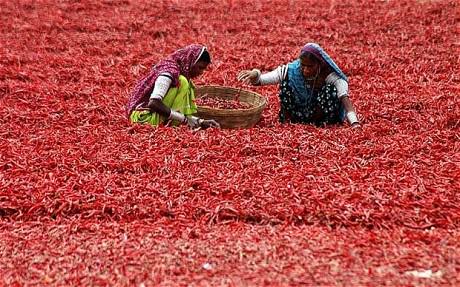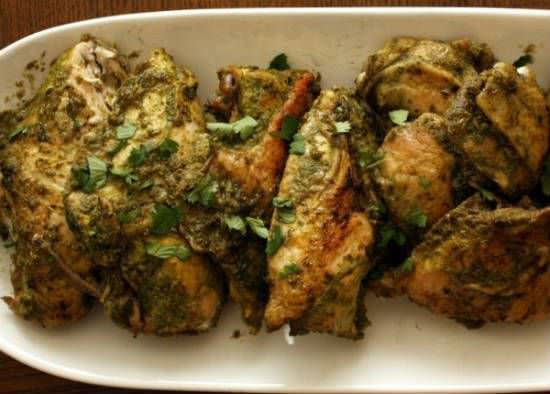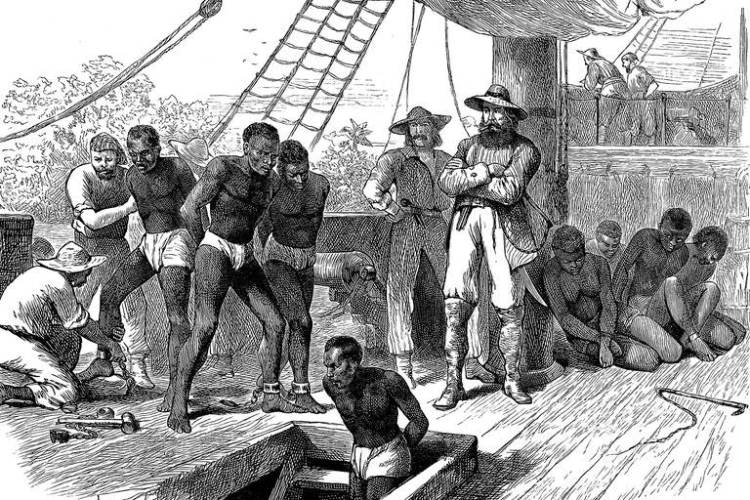I passed by a little food shack in Baga, Goa with a signboard that read ‘Indian food! Good curry here.’ When you see the word ‘curry’, you’d probably think about a ‘ spicy gravy with naan on the side.’
But how Indian is curry?

North Indian curry (Source: Google)
What we eat or don’t eat is always a continuing process of marking out cultural boundaries in a country. Curry is associated with India. Similarly, fish and chips are British. When in Spain, drink sangria and schezwan fried rice is associated with China (but it is not real Chinese food!)
For many of us, the curry’s addictive chili heat is synonymous with Indian food, but until the 16th century, no Indian cook had ever added chili to their pot. India is now the largest consumer and exporter of chilies in the world, but until the Portuguese rampaged through the southern state of Goa in the early 16th century, black peppercorns were the Indian cook’s only source of spicy heat.

Indian rural women drying out chilies. Source: Wikipedia
On 20th May 1498, Vasco da Gama, the Portuguese explorer arrived at Calicut. With his entry into India, the Portuguese had colonized Goa by 1510. However, the most important change Vasco da Gama brought to India was that he changed the food we eat today.
 1498: Vasco da Gama reaches India (Source: Quora)
1498: Vasco da Gama reaches India (Source: Quora)
The chili was in fact brought by the Portuguese from Brazil to Goa after which it spread to the rest of the country. In the Vedas and Upanishads, there is no mention of chilies. The book, Ain A Akbari which was written in 1590 described 150 dishes cooked in Akbar's kitchen. The dishes were cooked with pepper, other spices and yes, no chilies.
 A painting of Akbar's kitchen (Source: The History Lab)
A painting of Akbar's kitchen (Source: The History Lab)
 Before the infusion of chili in Indian cuisine, the Mughal dishes used pepper. (Source: Quora)
Before the infusion of chili in Indian cuisine, the Mughal dishes used pepper. (Source: Quora)
The first mention of chili in Indian literature was found in a poem by saint poet Purandara Dāsa from Hampi in 1555. He wrote,
The blending of Portuguese ingredients like the chili with local ingredients created a unique Goan culinary language. The Goan dish popularly known as Chicken Cafreal is a prime example of this infusion. The dish consists of grilled chicken marinated in coriander, chilies, cinnamon, garlic and lime juice.
 Chicken Cafreal (Source: Google)
Chicken Cafreal (Source: Google)
The Chicken Cafreal has an interesting origin in India.
African slaves were once recruited to the Portuguese army during their colonial rule in Goa. In one such army camp, the slaves cooked some chicken using local spices and coriander (which came from Europe).
The Portuguese officers liked the chicken dish so much that they named it ‘Chicken Cafreal’. It was called Cafreal because the colonized Africans at the time were called 'Kafirs' by the Arabs.
Chicken Cafreal has become the most popular dish in Goa as well as Portugal right now.
 African slaves were transported to the East (Source: The Museum of Uncut Funk)
African slaves were transported to the East (Source: The Museum of Uncut Funk)
 The African slaves incorporated many of their cooking techniques in Goa's cuisine. (Source: The Museum of Uncut Funk)
The African slaves incorporated many of their cooking techniques in Goa's cuisine. (Source: The Museum of Uncut Funk)
It was with the entry of the Portuguese that a floodgate of new vegetables entered the Indian land and kitchens. They brought potato, tomato, tapioca, groundnuts, corn, papaya, pineapple, guava, avocado, rajma (kidney bean), cashew, sapota (chiku), and capsicum to India.
When tomatoes came to India, the Brahmin class refused to eat it. They believed that when the tomato is cut in half, the flesh of the fruit resembled the flesh of meat.
(Yes, the tomato is a fruit.)
In South India, the late Sangam texts (6th c. AD) mention the dosai, but not the idli, which in its present form, is suggested to be an import from Indonesia with which wide trade links existed since the seventh century. Possibly a cook in a king's kitchen may have brought back the idea of fermentation and steaming of dosai.
 Indian cuisine (Source: Google)
Indian cuisine (Source: Google)
It just goes to show that western and eastern ingredients have been strongly infused in our Indian palettes.
The next time you eat ghar ka khana and you taste the prick of the chili, remember the way its flavor has changed communities, economies and cultures, thousands of miles and hundreds of years apart.
But how Indian is curry?

North Indian curry (Source: Google)
What we eat or don’t eat is always a continuing process of marking out cultural boundaries in a country. Curry is associated with India. Similarly, fish and chips are British. When in Spain, drink sangria and schezwan fried rice is associated with China (but it is not real Chinese food!)
For many of us, the curry’s addictive chili heat is synonymous with Indian food, but until the 16th century, no Indian cook had ever added chili to their pot. India is now the largest consumer and exporter of chilies in the world, but until the Portuguese rampaged through the southern state of Goa in the early 16th century, black peppercorns were the Indian cook’s only source of spicy heat.

Indian rural women drying out chilies. Source: Wikipedia
On 20th May 1498, Vasco da Gama, the Portuguese explorer arrived at Calicut. With his entry into India, the Portuguese had colonized Goa by 1510. However, the most important change Vasco da Gama brought to India was that he changed the food we eat today.
 1498: Vasco da Gama reaches India (Source: Quora)
1498: Vasco da Gama reaches India (Source: Quora)The chili was in fact brought by the Portuguese from Brazil to Goa after which it spread to the rest of the country. In the Vedas and Upanishads, there is no mention of chilies. The book, Ain A Akbari which was written in 1590 described 150 dishes cooked in Akbar's kitchen. The dishes were cooked with pepper, other spices and yes, no chilies.
 A painting of Akbar's kitchen (Source: The History Lab)
A painting of Akbar's kitchen (Source: The History Lab) Before the infusion of chili in Indian cuisine, the Mughal dishes used pepper. (Source: Quora)
Before the infusion of chili in Indian cuisine, the Mughal dishes used pepper. (Source: Quora)The first mention of chili in Indian literature was found in a poem by saint poet Purandara Dāsa from Hampi in 1555. He wrote,
"Oh chili!
I have seen you become red from green.
You have made my food so tasty and delicious
that when I eat you,
I even forget to utter the name of Vittala."
The blending of Portuguese ingredients like the chili with local ingredients created a unique Goan culinary language. The Goan dish popularly known as Chicken Cafreal is a prime example of this infusion. The dish consists of grilled chicken marinated in coriander, chilies, cinnamon, garlic and lime juice.
 Chicken Cafreal (Source: Google)
Chicken Cafreal (Source: Google)The Chicken Cafreal has an interesting origin in India.
African slaves were once recruited to the Portuguese army during their colonial rule in Goa. In one such army camp, the slaves cooked some chicken using local spices and coriander (which came from Europe).
The Portuguese officers liked the chicken dish so much that they named it ‘Chicken Cafreal’. It was called Cafreal because the colonized Africans at the time were called 'Kafirs' by the Arabs.
Chicken Cafreal has become the most popular dish in Goa as well as Portugal right now.
 African slaves were transported to the East (Source: The Museum of Uncut Funk)
African slaves were transported to the East (Source: The Museum of Uncut Funk) The African slaves incorporated many of their cooking techniques in Goa's cuisine. (Source: The Museum of Uncut Funk)
The African slaves incorporated many of their cooking techniques in Goa's cuisine. (Source: The Museum of Uncut Funk)It was with the entry of the Portuguese that a floodgate of new vegetables entered the Indian land and kitchens. They brought potato, tomato, tapioca, groundnuts, corn, papaya, pineapple, guava, avocado, rajma (kidney bean), cashew, sapota (chiku), and capsicum to India.
When tomatoes came to India, the Brahmin class refused to eat it. They believed that when the tomato is cut in half, the flesh of the fruit resembled the flesh of meat.
(Yes, the tomato is a fruit.)
In South India, the late Sangam texts (6th c. AD) mention the dosai, but not the idli, which in its present form, is suggested to be an import from Indonesia with which wide trade links existed since the seventh century. Possibly a cook in a king's kitchen may have brought back the idea of fermentation and steaming of dosai.
 Indian cuisine (Source: Google)
Indian cuisine (Source: Google)It just goes to show that western and eastern ingredients have been strongly infused in our Indian palettes.
The next time you eat ghar ka khana and you taste the prick of the chili, remember the way its flavor has changed communities, economies and cultures, thousands of miles and hundreds of years apart.








